
The true finches are small to medium-sized passerine birds in the family Fringillidae. Finches have stout conical bills adapted for eating seeds and nuts and often have colourful plumage. They occupy a great range of habitats where they are usually resident and do not migrate. They have a worldwide distribution except for Australia and the polar regions. The family Fringillidae contains more than two hundred species divided into fifty genera. It includes species known as siskins, canaries, redpolls, serins, grosbeaks and euphonias.

A passerine is any bird of the order Passeriformes, which includes more than half of all bird species. Sometimes known as perching birds or songbirds, passerines are distinguished from other orders of birds by the arrangement of their toes, which facilitates perching.
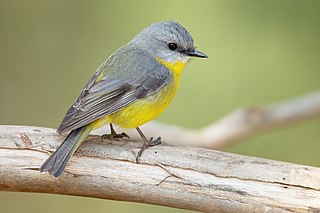
A songbird is a bird belonging to the clade Passeri of the perching birds (Passeriformes). Another name that is sometimes seen as the scientific or vernacular name is Oscines, from Latin oscen, "a songbird". The group contains 5000 or so species found all over the world, in which the vocal organ typically is developed in such a way as to produce a diverse and elaborate bird song.

The waxwings are three species of passerine birds classified in the genus Bombycilla. They are pinkish-brown and pale grey with silky plumage, a black and white eyestripe, a crest, a square-cut tail and pointed wings. Some of the wing feathers have red tips, the resemblance of which to sealing wax gives these birds their common name. According to most authorities, this is the only genus placed in the family Bombycillidae, although sometimes the family is extended to include related taxa that are more usually included in separate families: silky flycatchers, Hypocolius (Hypocoliidae), Hylocitrea (Hylocitreidae), palmchats (Dulidae) and the Hawai'ian 'honeyeaters' (Mohoidae). There are three species, the Bohemian waxwing, the Japanese waxwing and the cedar waxwing.

The New Zealand wrens are a family (Acanthisittidae) of tiny passerines endemic to New Zealand. They were represented by six known species in four or five genera, although only two species survive in two genera today. They are understood to form a distinct lineage within the passerines, but authorities differ on their assignment to the oscines or suboscines. More recent studies suggest that they form a third, most ancient, suborder Acanthisitti and have no living close relatives at all. They are called "wrens" due to similarities in appearance and behaviour to the true wrens (Troglodytidae), but are not members of that family.
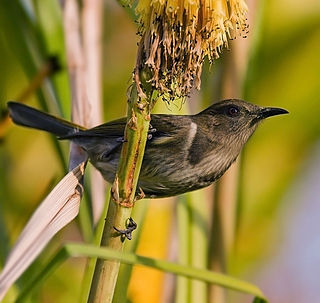
The honeyeaters are a large and diverse family, Meliphagidae, of small to medium-sized birds. The family includes the Australian chats, myzomelas, friarbirds, wattlebirds, miners and melidectes. They are most common in Australia and New Guinea, and found also in New Zealand, the Pacific islands as far east as Samoa and Tonga, and the islands to the north and west of New Guinea known as Wallacea. Bali, on the other side of the Wallace Line, has a single species.

The grey hypocolius or simply hypocolius is a small passerine bird species. It is the sole member of the genus Hypocolius and it is placed in a family of its own, the Hypocoliidae. This slender and long tailed bird is found in the dry semi-desert region of northern Africa, Arabia, Afghanistan, Pakistan, and western India. They fly in flocks and forage mainly on fruits, migrating south in winter.

The bird family Petroicidae includes 49 species in 19 genera. All are endemic to Australasia: New Guinea, Australia, New Zealand and numerous Pacific Islands as far east as Samoa. For want of an accurate common name, the family is often called the Australasian robins. Within the family species are known variously as robins, scrub-robins and flyrobins. They are only distantly related to the European robin of Europe, north Africa and western Asia, a member of family Muscicapidae.

The rosefinches are a genus, Carpodacus, of passerine birds in the finch family Fringillidae. Most are called "rosefinches" and as the word implies, have various shades of red in their plumage. The common rosefinch is frequently called the "rosefinch". The genus name is from Ancient Greek karpos, "fruit" and dakno, "to bite".
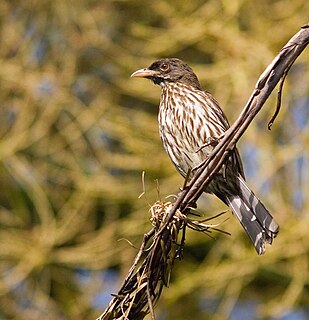
The palmchat is a small, long-tailed passerine bird, the only species in the genus Dulus and the family Dulidae endemic to the Caribbean island of Hispaniola. It is related to the waxwings, family Bombycillidae. Its name reflects its strong association with palms for feeding, roosting, and nesting.

Passerida is, under the Sibley-Ahlquist taxonomy, one of two parvorders contained within the suborder Passeri. While more recent research suggests that its sister parvorder, Corvida, is not a monophyletic grouping, the Passerida as a distinct clade are widely accepted.

The kioea was a Hawaiian bird that became extinct around 1859. The kioea was in decline even before the discovery of Hawaiʻi by Europeans. Even native Hawaiians are seemingly unfamiliar with this bird. The feathers of the kioea were not used in Hawaiian featherwork, nor is it mentioned in any chants or legends. Only four specimens exist in museums.
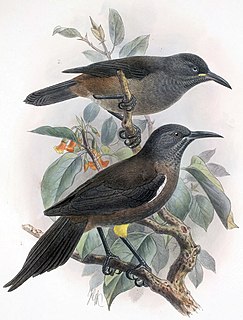
Moho is a genus of extinct birds in the Hawaiian bird family, Mohoidae, that were endemic to the Hawaiian Islands. Members of the genus are known as ʻōʻō in the Hawaiian language. Their plumage was generally striking glossy black; some species had yellowish axillary tufts and other black outer feathers. Most of these species became extinct by habitat loss and by extensive hunting because their plumage was used for the creation of precious ʻaʻahu aliʻi (robes) and ʻahu ʻula (capes) for aliʻi. The Kauaʻi ʻōʻō was the last species of this genus to become extinct, probably a victim of avian malaria.

Cettiidae is a newly validated family of small insectivorous songbirds ("warblers"), formerly placed in the Old World warbler "wastebin" assemblage. It contains the typical bush warblers (Cettia) and their relatives. As a common name, cettiid warblers is usually used.

The hylocitrea, also known as the yellow-flanked whistler or olive-flanked whistler, is a species of bird that is endemic to montane forests on the Indonesian island of Sulawesi. It is monotypic within the genus Hylocitrea, and has traditionally been considered a member of the family Pachycephalidae, but recent genetic evidence suggests it should be placed in a monotypic subfamily of the family Bombycillidae, or even its own family, Hylocitreidae. A 2019 study found it to be a sister group to a clade containing the hypocolius (Hypocoliidae) and the extinct Hawaiian honeyeaters (Mohoidae), with the clade containing all three being a sister group to the silky-flycatchers (Ptiliogonatidae). The divergences forming these families occurred in the early Miocene, about 20-23 million years ago.
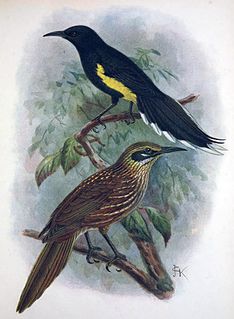
Mohoidae is a family of Hawaiian species of recently extinct, nectarivorous songbirds in the genera Moho (ʻōʻō) and Chaetoptila (kioea). These now extinct birds form their own family, representing the only complete extinction of an entire avian family in modern times, when the disputed family Turnagridae is regarded as invalid. The last surviving species in the family, the Kauaʻi ʻōʻō, went extinct in 1987.

The laughingthrushes are a family of Old World passerine birds. They are diverse in size and coloration. These are birds of tropical areas, with the greatest variety in Southeast Asia and the Indian subcontinent. The entire family used to be included in the Old World babbler family Timaliidae.

Muscicapida is a clade of birds in the order Passeriformes. Oliveros, C.H. et al. (2019) suggested a gondwanan migration of this lineage from Australia to Eurasia.


















